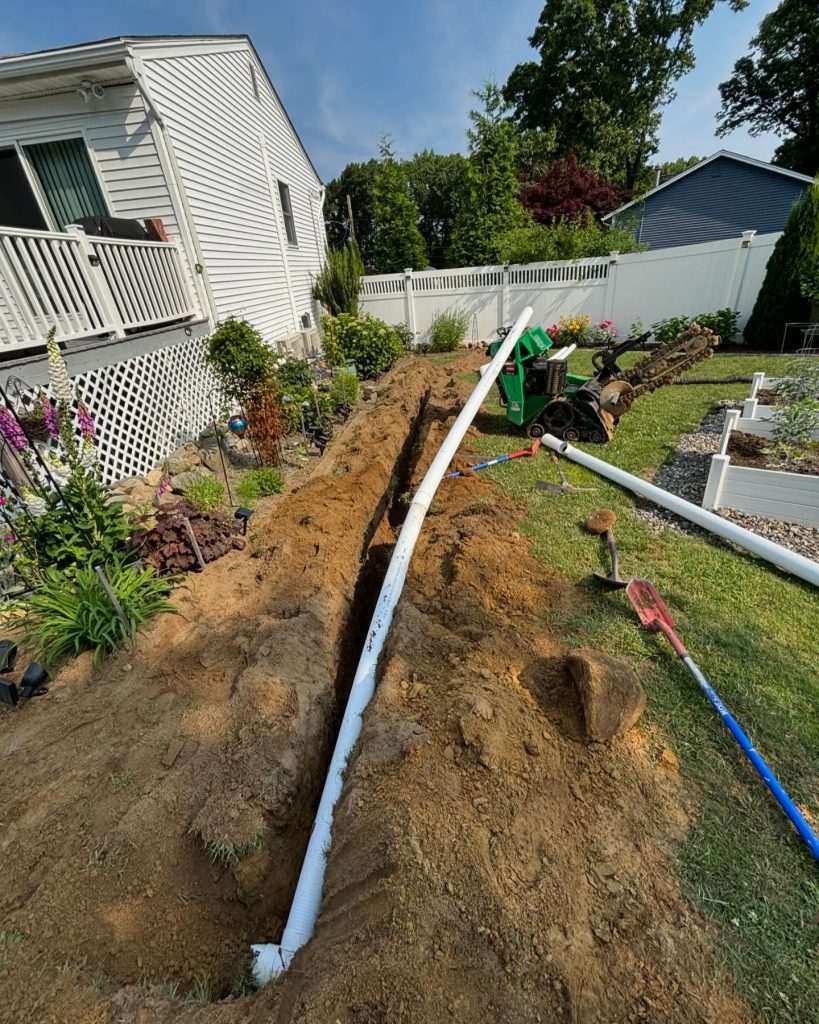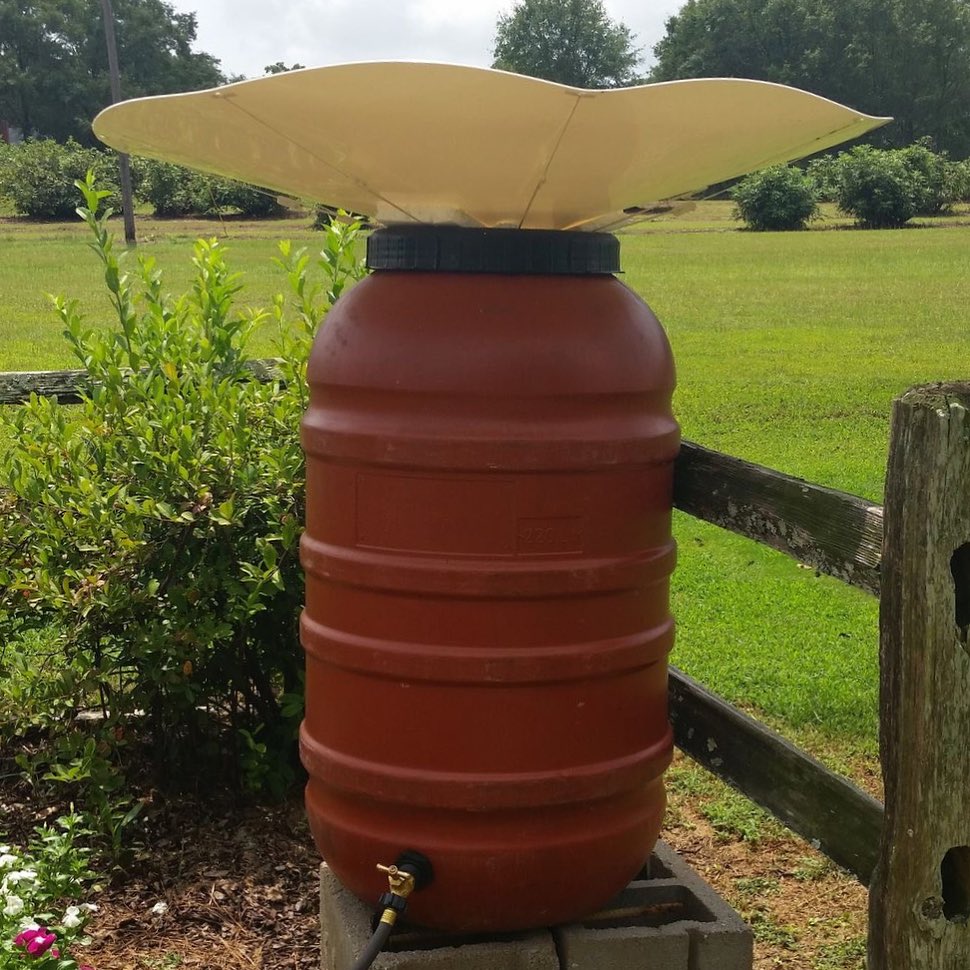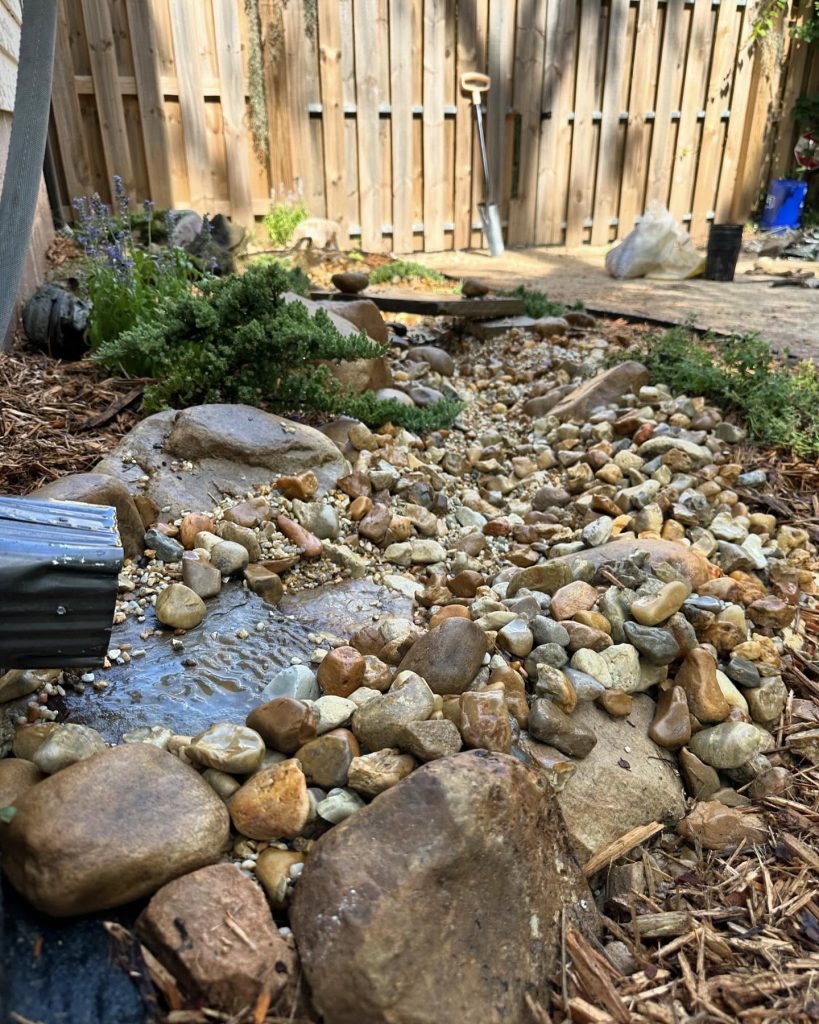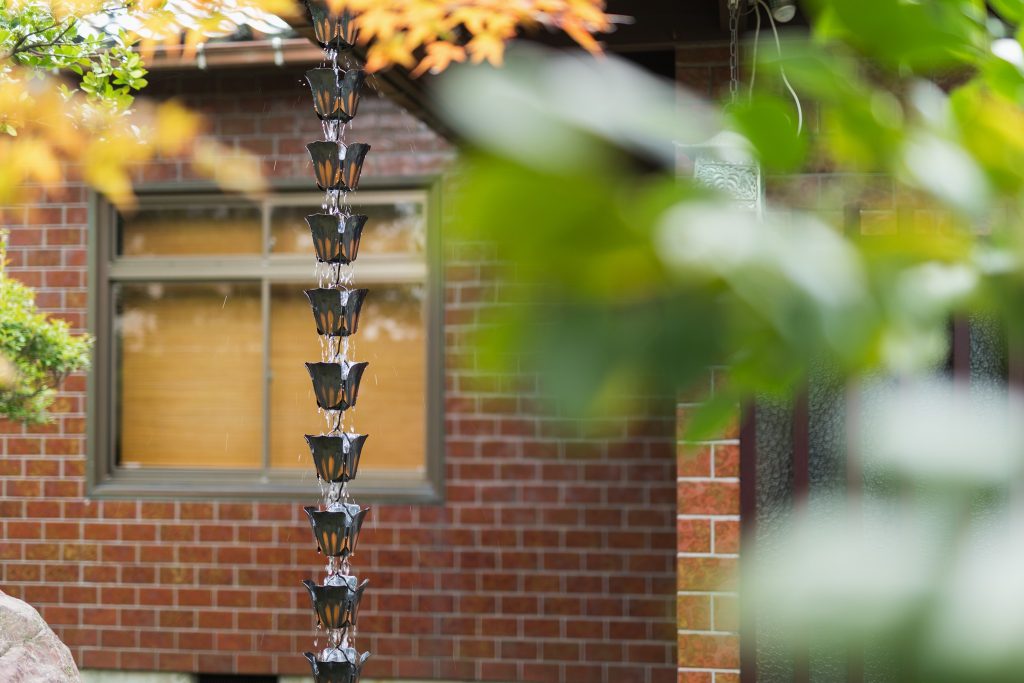Effective rain gutter drainage is essential for maintaining the health of your home and garden. Improper drainage can lead to water damage, flooding, and erosion, while a well-executed drainage system can protect your property and enhance the beauty of your yard. This article provides 23 innovative and practical rain gutter drainage ideas that will not only help manage rainwater but also add an aesthetic touch to your outdoor space.
1. French Drain System

A French drain is a simple yet highly effective solution for redirecting rainwater away from your home’s foundation. It consists of a trench filled with gravel or rock, with a perforated pipe at the bottom to allow water to flow through. The design helps prevent water from pooling near the foundation, which can lead to leaks, cracks, and water damage.
French drains are especially useful in areas with heavy rainfall or on sloped landscapes. They can be integrated into the garden or yard, with minimal disruption to the overall design. While the trench itself may require a bit of digging, it’s a relatively low-maintenance solution once installed.
Installation Tip: Make sure the trench has a proper slope so that water can flow freely through the perforated pipe. You may also want to plant grass or ground cover over the gravel to blend the drain seamlessly with your landscape.
2. Rain Barrel Collection System

Rain barrels are an eco-friendly solution for capturing rainwater from your gutters, which can be repurposed for watering plants or cleaning outdoor spaces. By installing a rain barrel at the end of your downspout, you can collect gallons of water during a rainfall. This helps reduce water consumption and is a great way to be environmentally conscious.
Rain barrels come in a variety of sizes and styles to match your home’s aesthetic. Some barrels are designed to look like decorative planters, while others come with an integrated spigot for easy access to the water. Make sure to place your barrel on a sturdy surface, such as a raised platform, so it can fill effectively.
Maintenance Tip: Clean your rain barrel regularly to prevent debris build-up and algae growth. You can also add a fine mesh screen to the top to keep leaves and insects out of the water.
3. Dry Creek Bed

A dry creek bed is a creative and natural way to manage water runoff in your yard. This drainage solution uses a trench lined with river rocks or pebbles to channel water away from your house and into the yard. It’s an ideal option for areas with moderate rainfall or slight slopes, and it also doubles as an attractive landscaping feature.
To create a dry creek bed, start by digging a trench where you want the water to flow. Line the trench with landscaping fabric to prevent weeds, then fill it with rocks of varying sizes. The varying rock sizes create an aesthetically pleasing look while allowing the water to filter through. You can even add plants around the edges of the creek bed to soften the look.
Design Tip: Incorporate plants such as ferns, wildflowers, and ornamental grasses along the creek bed’s edges to enhance its visual appeal and help control erosion.
4. Rain Chain

Rain chains are a beautiful and functional alternative to traditional downspouts. These decorative chains direct rainwater from your roof to the ground, creating a cascading effect that adds a charming touch to your home’s exterior. Rain chains are often made of metal, such as copper or aluminum, and are available in a variety of designs, from simple links to more intricate shapes like cups or flowers.
Installing a rain chain involves replacing your downspout with the chain, which is attached to the roof with a hanger. The water flows down the chain and is directed into a rain barrel, garden bed, or drainage system. Not only do rain chains serve a practical purpose, but they also enhance the ambiance of your outdoor space, especially during a rainfall.
Aesthetic Tip: Position your rain chain near a flowerbed or patio area where you can enjoy the soothing sound of water cascading down.
5. Curb Cut and Swale
Source
Curb cuts and swales are ideal for homes with long driveways or extensive lawn areas. A curb cut involves creating a small gap in the curb along your driveway or sidewalk, which allows water to flow into a swale – a shallow trench designed to carry water away from your foundation and into a lower area of the yard.
This drainage solution is particularly effective for directing water away from your driveway or sidewalk, which can often become flooded during heavy rains. Swales can be lined with grass or gravel for added functionality and beauty.
Design Tip: Use plants that thrive in wet conditions, such as sedges and rushes, to line the swale, adding texture and color to the drainage area.
6. Catch Basin
Source
Catch basins are a popular choice for homes with persistent water pooling or frequent flooding. These devices are installed in the ground near your downspout to collect water as it drains from your gutters. Once the basin collects the water, it channels it into a drainage pipe or another runoff system that directs the water away from your foundation.
Catch basins are relatively easy to install and can be a permanent solution for dealing with problematic drainage. They are especially effective in low-lying areas that collect large amounts of water after rainfall.
Installation Tip: Ensure the catch basin is placed at the lowest point in the area to catch the maximum amount of water and prevent pooling.
7. Rain Garden
Source
A rain garden is a sustainable and visually stunning solution for managing rainwater runoff. By designing a garden that is specifically tailored to absorb excess water, you can turn a potential drainage issue into an eco-friendly feature of your yard. Rain gardens use plants that are well-suited for wet conditions, such as native grasses, flowers, and shrubs.
When designing a rain garden, choose a location that receives runoff from your gutters or downspouts. The plants in the rain garden will help filter the water, preventing soil erosion and promoting healthy water absorption into the ground. Additionally, rain gardens provide habitats for local wildlife and pollinators.
Plant Selection Tip: Choose native plants that are adapted to your region’s climate and soil conditions to ensure that your rain garden thrives year-round.
8. Gutter Extension
Source
A gutter extension is one of the simplest and most affordable ways to extend the reach of your gutter system and direct water farther away from your home. Gutter extensions come in various materials, such as flexible tubing or rigid PVC, and can be installed directly onto the downspout.
These extensions help prevent water from pooling near the foundation or splashing onto landscaping features. They can be adjusted in length, depending on the distance you need to divert the water, and are available in several colors to blend seamlessly with your home’s exterior.
Installation Tip: Make sure the extension is directed toward an area where water can flow freely, such as a lawn or garden bed, to avoid creating new drainage problems.
9. Permeable Pavers for Drainage
Source
Permeable pavers are an excellent choice for outdoor areas that require both aesthetic appeal and effective water drainage. Unlike traditional solid pavers, permeable pavers allow rainwater to seep through the gaps between the stones, filtering water into the ground below. This reduces surface runoff and helps prevent flooding in your yard.
Permeable pavers can be used for driveways, patios, walkways, or any area where you need to manage water runoff while maintaining a beautiful surface. They are available in a variety of materials, including concrete, brick, and natural stone, to suit any outdoor design.
Design Tip: Combine permeable pavers with other landscaping elements, such as garden beds or shrubs, to create a cohesive and functional outdoor space.
10. Underground Drainage Pipes
Source
Underground drainage pipes are a discreet and efficient solution for managing rainwater runoff. These pipes are installed beneath the surface of your yard and connect to your downspouts, channeling water away from your home’s foundation and out to a designated area in the yard.
This drainage option is ideal for homes with a lot of landscaping or those that want to keep their yard looking neat and tidy. Once installed, the pipes are hidden from view, allowing your yard to remain aesthetically pleasing while efficiently managing rainwater.
Installation Tip: Ensure the pipes have a slight slope to encourage water flow and prevent clogs. You can also add a catch basin or gravel pit at the end of the pipe for added drainage.
11. Rock Garden Water Feature
Source
A rock garden water feature can add a dramatic and serene touch to your yard while helping with water drainage. By incorporating large rocks, boulders, and a small pond or fountain, you can create an attractive area that diverts rainwater away from the foundation.
This solution is especially beneficial for areas with moderate rainfall and can also act as a focal point for your landscape design. The rocks absorb water and allow it to slowly filter into the ground, reducing the risk of erosion and flooding.
Design Tip: Add plants around the water feature, such as ferns or creeping thyme, to enhance the natural look and feel of the rock garden.
12. Gutter Guards and Covers
Source
Gutter guards and covers are protective devices that fit over your gutters to prevent leaves, twigs, and other debris from clogging the system. By keeping gutters clear, these guards allow water to flow freely, which improves overall drainage performance.
Gutter guards come in various types, including mesh screens, solid covers, and foam inserts. They are easy to install and can be a long-term solution for maintaining efficient drainage without frequent cleaning.
Maintenance Tip: Check gutter guards periodically to ensure they are not clogged with debris or damaged, which could impede water flow.
13. Deck Drainage System
Source
If you have a raised deck, a deck drainage system can help redirect rainwater that collects beneath it. This system works by installing channels or troughs under the deck to collect and divert water away from the structure, preventing pooling and moisture damage.
Deck drainage systems are available in several styles, including systems that integrate with the deck’s structure or external systems that sit below the deck. They are an excellent solution for keeping the area beneath the deck dry, which can also make it a more usable space.
Design Tip: Choose a drainage system that complements your deck’s aesthetic and ensures proper water redirection.
14. Channel Drains
Source
Channel drains, also known as trench drains, are a practical and efficient way to manage water runoff in areas that experience heavy rainfall. These drains are installed along the surface of your driveway, patio, or other paved areas, and they allow rainwater to flow into the drain before it can pool or cause damage.
Channel drains are typically made of durable materials like concrete, plastic, or stainless steel and come in various widths and depths to accommodate different types of runoff. They’re especially useful for flat areas that might not have natural slopes to direct water away from your home. Channel drains can be integrated into your landscape design for a clean and modern look.
Installation Tip: Consider installing a channel drain along high-traffic areas like walkways or driveways where water tends to collect after a heavy rain. You can also combine it with decorative grates to match your outdoor décor.
15. Bermed Drainage Path
Source
A berm is a raised mound of earth, often used to redirect water away from sensitive areas, such as your home’s foundation or garden beds. When combined with a drainage path, a berm can be an effective way to manage rainwater runoff. The berm acts as a barrier that forces water to flow along the drainage path, which can be lined with rocks or other materials to help guide the water to a designated drainage area.
Berms can also enhance the visual appeal of your yard by adding elevation and creating a natural look. They are particularly effective in sloped yards where water naturally flows downhill, and they help prevent erosion and flooding.
Design Tip: Plant drought-tolerant grasses or wildflowers along the berm to create a natural, low-maintenance landscape feature.
16. Gutter Splash Guards
Source
Gutter splash guards are a simple and inexpensive solution to prevent water from splashing out of the gutter system and onto your landscaping. These guards are installed at the end of the downspout to redirect water away from your plants, mulch, or garden beds.
Splash guards come in various designs, including long, curved pieces of metal or plastic that funnel the water into a specific direction. They are ideal for homeowners who want to keep their gardens intact and avoid soil erosion caused by excessive water splashing from the gutters.
Installation Tip: Position splash guards at the end of your downspout to guide water toward an area where it can be safely absorbed, such as a garden bed or lawn.
17. Surface Drainage Grates
Source
Surface drainage grates are another effective solution for managing water runoff in areas where the ground is flat or has minimal slope. These grates are typically placed over surface drains, allowing water to flow into the drainage system while keeping debris out.
The grates come in a variety of materials, including steel, aluminum, and cast iron, and can be designed to match the aesthetic of your outdoor space. Surface drainage grates are especially useful for patios, driveways, and pool decks, where water can pool quickly and create a slipping hazard.
Design Tip: Choose a grate design that complements your patio or driveway, or opt for decorative grates with patterns that add an elegant touch to your outdoor design.
18. Gutter Downspout Diverter
Source
A downspout diverter is a smart device that allows you to easily redirect rainwater from your gutters to other areas of your yard. This device is attached to the downspout and can be adjusted to direct water to a rain barrel, a garden bed, or any other area in need of water.
Downspout diverters are especially useful for homeowners who want to use rainwater efficiently and avoid letting it run off to areas where it may cause flooding or erosion. These diverters are easy to install and can be customized to suit your drainage needs.
Installation Tip: Ensure that the diverter is properly installed and securely attached to your downspout to avoid any water leakage or diversion issues.
19. Infiltration Trench
Source
An infiltration trench is another creative and effective drainage solution that helps rainwater absorb back into the ground. It consists of a deep trench filled with rocks or gravel and lined with landscaping fabric. Water flows into the trench, where it gradually infiltrates the soil below, reducing runoff and preventing flooding.
Infiltration trenches are best used in areas with moderate rainfall and can be installed along driveways, pathways, or near the foundation of your home. They can also be integrated into the landscape with decorative plants or flowers to create a visually appealing solution.
Design Tip: Incorporate native plants along the edge of the infiltration trench to help with water absorption and erosion control.
20. Vegetated Swale
Source
A vegetated swale is a natural, plant-filled ditch that helps direct water away from your property and into areas that can absorb it, such as a garden or a grassy lawn. Swales are designed to slow down the flow of water, giving it time to filter into the ground, reducing erosion and preventing runoff.
Vegetated swales are typically planted with grasses, wildflowers, or native shrubs that thrive in wet conditions. They are a great addition to large yards and properties that experience heavy rainfall, as they manage large amounts of water without the need for complex drainage systems.
Plant Selection Tip: Opt for native plants that can handle both wet and dry conditions for a low-maintenance, sustainable solution.
21. Water-Tolerant Ground Covers
Source
If you have areas of your yard that tend to get soggy or collect water after a rain, planting water-tolerant ground covers is an excellent way to help manage the drainage. These plants are designed to thrive in moist conditions and can help absorb excess water while preventing soil erosion.
Ground covers such as creeping thyme, mint, and sedges are ideal for areas that are prone to waterlogging. They can also provide an attractive, low-maintenance alternative to grass in parts of your yard that are difficult to mow or maintain.
Design Tip: Choose a variety of ground covers to add texture and visual interest to your yard while helping manage water runoff.
22. Green Roof Systems
Source
Green roofs are an innovative and sustainable solution for managing rainwater on urban homes or buildings. These roofs are covered with plants that help absorb rainwater, reduce runoff, and provide insulation for your home. Green roofs can significantly decrease the amount of water that flows into your gutters, making them an effective way to manage excess rainwater.
While green roofs may require a bit more investment and maintenance, they offer many benefits, including improved air quality, enhanced aesthetic appeal, and energy efficiency. They also provide a habitat for local wildlife and pollinators.
Design Tip: If you are considering a green roof, consult with professionals to ensure that your roof structure can support the weight of the plants and soil.
23. Rainwater Cistern
Source
A rainwater cistern is a large storage container that collects rainwater from your gutters and stores it for later use. This system is ideal for homes in areas that experience irregular rainfall or drought conditions. A cistern can store large amounts of water, which can then be used for irrigation, landscape maintenance, or even indoor use if properly filtered.
Cisterns are typically placed above or below ground and can be connected to your home’s gutter system. They come in a variety of sizes, from small barrels to large underground tanks. A well-designed cistern can help you conserve water, reduce water bills, and maintain a sustainable landscaping system.
Installation Tip: Ensure that the cistern is properly sealed to prevent contamination and that it is placed in an area that can be easily accessed for maintenance.
Conclusion
Managing rain gutter drainage is essential for protecting your home and yard from water damage while creating an aesthetically pleasing outdoor space. Whether you opt for simple solutions like gutter extensions or more intricate designs such as rain gardens and green roofs, the key is to choose a system that works for your specific needs and landscaping style. These 23 drainage ideas offer a range of options that are both functional and visually appealing, helping you transform your yard into a well-managed and beautiful space.
By implementing one or more of these ideas, you can reduce water runoff, prevent flooding, and create a more sustainable outdoor environment. With proper drainage, you can protect your foundation, enhance your landscape, and enjoy your outdoor space for years to come.

